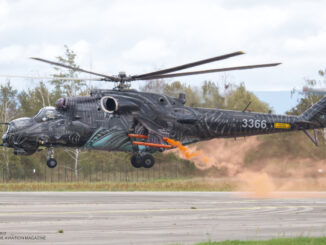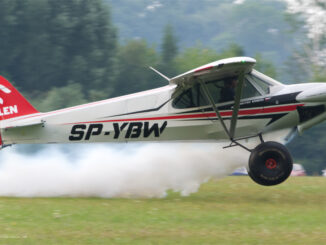 Dornier Do 28D2 Skyservant (c/n 4186, D-IRES, formerly 59+11 of the Luftwaffe) taxiing at Roudnice airfield runway during Memorial Air Show 2019, Roudnice nad Labem, Czech Republic, June 2019.
Dornier Do 28D2 Skyservant (c/n 4186, D-IRES, formerly 59+11 of the Luftwaffe) taxiing at Roudnice airfield runway during Memorial Air Show 2019, Roudnice nad Labem, Czech Republic, June 2019.
Speaking of Dornier Do 28, a West-German STOL utility aircraft is the first thing that comes to mind. However, it should not be forgotten that designation was used twice and means two completely different aircraft – although both were designed at Dornier and served the same duty.
At the beginning, there was Dornier Do 28A, the twin-engine STOL aeroplane developed from a single engine Do 27 utility aeroplane. The Do 27 performed its maiden flight on 27th June 1955 and shortly after became the first mass-produced German aircraft after the World War II.
The Do 28A was sharing the same design of a high-wing monoplane as its predecessor. The only difference was it used two Lycoming O-540 engines, each generating 255 hp. They were placed in round-shaped nacelles mounted through struts above the main landing gear through struts and attached to the underwing. Prototype of the Do 28A performed its first flight on 29th April 1959. The aircraft can carry up to six passengers.
The new Dornier aircraft was intended for military operators. The aeroplane quickly gained recognition for its excellent low-speed flight characteristics and exceptional STOL capabilities, even from rough and unpaved airstrips. Shortly afterwards, an upgraded variant designated Do 28B was introduced into the market – equipped with two Lycoming IO-540 engines of 290 hp each, and three-blade propellers. A total number of 120 aircraft in both the A and B variants was manufactured.
In the middle of the 1960s, the West German government assigned the Dornier company the task of creating another STOL aeroplane, but significantly bigger and able to carry up to thirteen passengers. It was designated Dornier Do 28D, although the general layout was the only thing that the new design shared with the Do 28A/B.
The Dornier development team made the new aircraft as simple as only possible. The goal was to allow the Do 28D to be operated in any conditions and to be maintained easily. Two Lycoming supercharged IGSO-540 engines, each of them generating 380hp, were chosen to power the Do 28D. The Do 28D engine nacelles were rectangular, as opposed to the Do 28A/B. In addition, the aeroplane was equipped with a large double door and could carry twelve passengers and two crew members.
The first flight of the new Dornier STOL utility aircraft took place on 23rd February 1966. One year later, the aeroplane was disclosed to general public at Le Bourget airport during the 1967 Paris Air Show. In addition to the type designation, the Do 28D was marketed as Skyservant – although its common nickname within the German armed forces was ´Bauernadler´, a peasant´s eagle.
The Do 28D is also widely known of its specific and strong on-board noise. Usually, it was perceived as annoying and causing that flying with a Skyservant was an unforgettable travel experience.
Serial production of the Do 28D was commenced in 1971. The aeroplane was widely used with the German armed forces, not only as a liaison and utility aircraft but also for maritime reconnaissance and pollution monitoring. There were approximately 150 aircraft of that type built and they served in approximately thirty air forces around the world.
It should be also mentioned here that two of the Do 28D were built as Signals Intelligence aircraft. They were acquired by Turkey and designated ´Anadolou´.
The Do 28D Skyservant was operationally used by the German armed forces until the mid-1990s, when it was replaced by Dornier 228. Some aircraft were sold to civilian operators and are preserved airworthy until today.
The Do 28D-2 D-IRES pictured within our Photo of the Week series is one of the two aeroplanes of that type operated by RK Flugdienst. It preserved its original livery of 59+11, from the time the aircraft was on duty with Marinefliegergeschwader 5 in Kiel Holtenau.



